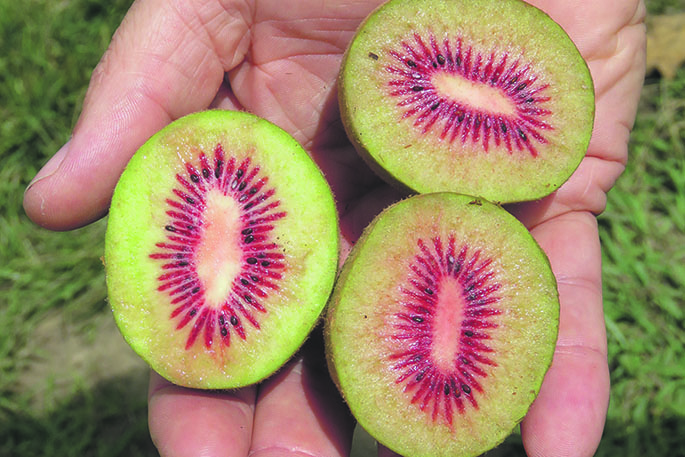For the first time red kiwifruit cultivars are being harvested and put through the entire export supply chain – on a contained scale – from being grown on a New Zealand orchard to reaching the mouth of an overseas consumer. Zespri International and Plant & Food Research’s jointly-run breeding programme is entering the third – and last – stage of evaluation in pre-commercialisation of a red variety. Zespri International’s operations manager for kiwifruit new cultivar development Bryan Parkes says harvesting of red fruit from the three cultivars is underway and it will go through the supply chain for two-three seasons “depending how things are tracking” before a business case is formed to decide whether to commercialise any of them. “We’re about four generations down the pipeline of improving the parents. Those parents have produced offspring and those seeds are being evaluated. Some of those seeds have been selected and cuttings have been put into clonal trials on different orchards around the country. That’s what we call the second stage of evaluation. “The third stage – we’re embarking on now – is where we take the very best of these and do pre-commercial trials,” says Bryan “This is where we truly put them in a largescale orchard environment and the growers grow them and we put that volume through the supply chain. “We take them to consumers, put them on the shelf, work with supermarkets, take them into consumers’ homes and see what they think of it. We find out if they store it in the fruit bowl or the fridge, are they happy with how long the eating window is in their environment. “Answering all of these things is going on in this third stage.” Bryan says they’re test-growing the three cultivars in NZ and Europe. “We will test them in Asia in the next few years. So we might grow it in NZ and it doesn’t store well and then grow it Italy and it does – it’s hard to predict what’s going on. “So when we’re optimising the performance of a cultivar sometimes the cultivars are very rigid and will be stable in performance across multiple climates. But sometimes its very plastic and flexes a lot in how performs in different environments. But until test them we will not know.” Bryan says there’s always a point at the precommercial stage when it has to be decided whether to proceed with commercial release. “We’re at the early stages of precommercial – we’re just getting the volume ramped up enough to undertake some real supply chain-level trials. That is this season’s activities. Preferably we do about two to three seasons depending how things are tracking. “Then at that point we would form up a business case to say: ‘Does this make sense to us as an industry, as a country, as Zespri’ – a it’s an incredibly cross-functional team that engages the whole industry. “Growers and supply chain, packhouses, research scientists, the marketing team, logistics teams, shipping teams, supermarkets – everyone is involved in testing this product. So it’s a bit like launching a rocket. They all have to give the green light for it to happen in each area for it to be good to launch – because everyone has to be happy with the ultimate product. That’s the process we’re going through.” Bryan says the programme has been working on a red kiwifruit for commercialisation for 20 years. “About seven years ago we were getting close to a commercial release of a red – we had a few in the programme but when Psa-V arrived it turned out those two cultivars were both too sensitive to Psa to be commercially viable. That was good news and bad news because it took us 10 years to get to that point – then they died in front of us, but at least they died before commercial release.” Bryan says the three cultivars being tested this season have all grown up in a Psa environment “we’re surrounded by it so anything growing now is almost by default Psa-tolerant”. So how confident is he that a red will be commercially released from the three cultivars on offer? “It is millions of dollars to evaluate varieties at this third stage – so you don’t do that lightly. The challenge is you learn a lot at every stage. So we’re learning a lot on how its performing in a commercial environment, at large-scale orchards – so you can never be 100 per cent confident that what you have will be commercially viable until you collect all of the data to show it is. “But we’re confident enough to spend a few millions to evaluate the varieties we’ve got. Based on that we either spend tens of hundreds of million dollars at the next stage – commercialisation. Or we don’t.” The new varieties breeding programme is funded by Zespri International, Plant & Food Research, and the NZ Government. It is managed by Plant & Food Research and Zespri International together. The total investment in the entire programme is about $35m a year.
Saturday, April 20, 2024
Posted: 3:46pm Tuesday 03 Apr, 2018 | By Merle Foster merle@thesun.co.nz
Red kiwifruit supply chain test a first

Some examples of red kiwifruit at Plant & Food Research in Te Puke.


0 Comments
Leave a Comment